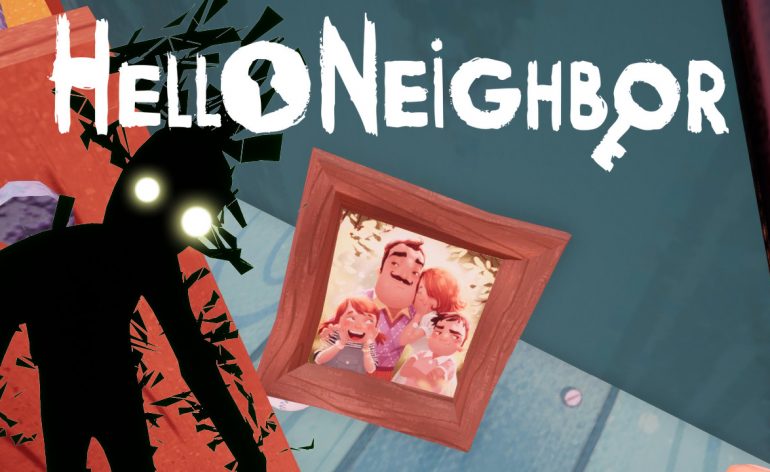Hello Neighbor – A surprisingly deep emotional journey.
This entire article is one big spoiler for the story of Hello Neighbor.
Followers of our podcast and Mixer channel know that I’ve been playing a bunch of Hello Neighbor in recent months. I thought of it as a goofy game with often weird physics and the occasional jump scare. It’s an entertaining game, but that’s about all I got from it. The third beta has been a staple of my streaming routine–I know it inside and out. While mine was one of the glitched versions that never actually ended, the ending itself was little more than a title card. I was completely unprepared for the level of emotional depth and storytelling that I found in the final release build of the game. Hello Neighbor is billed as a stealth horror game, but that doesn’t scratch the surface of what this game really is.
Hello Neighbor in three acts
First of all, telling the story of the game over the course of several years through multiple acts is amazing. However, it’s more than just the passage of time. We’re moving through the stages of the player character’s life and how he deals with personal trauma. The neighbor is both a character (possibly an abuser) and a metaphor. Act 1 begins with the loss of the player’s childhood as he innocently chases a ball down the street. The neighbor, angry at and terrorized by a thing we don’t see, desperately fights to hide a dark secret behind a pleasant facade. The player is left to discover this secret but finds only his own darkness. The neighbor finds the player delving into the basement he tries to keep locked away from the world and seems to lock him away as well.
Act 2 picks up as the player wakes up imprisoned in this same basement, trapped in a room that projects false freedom through its windows. He is given an opportunity to escape, but only by finding a way around the walls now built up around the neighbor’s house. The house is now a prison yard that makes no sense and full of danger. Labyrinthine in design, it provides several opportunities for escape if the player can find the proper tools. An item of note is the key to the dollhouse buried out back in a shallow grave. This reiterates the theme of a lost childhood and the burying of painful as well as happy memories. The improbable design of the house is difficult to navigate and I did not explore it fully before finding my freedom. So much was left unresolved.
Act 3 sees the player wake from a troubled sleep only to be evicted from his small apartment in the city. He returns to the home of his youth, where the memories of his childhood trauma still linger. The neighbor’s house is rubble, but exploring it gives us our first glimpse of what I’ll call the Shadow Man. He lays down on his couch and is awoken by a scream. The neighbor’s house is restored and even more chaotic than before. Much of it is built haphazardly and parts hang precariously off of it. The exterior appearance is one of overcompensation to appear happy. It incorporates bright colors, a train, and a windmill, but still has a crashed car on the lawn as a reminder of what started it all. Only by returning once more to the basement and confronting what hides within can he finally be free of it.
The neighbor’s story
It is through failure that we learn the most. In the case of Hello Neighbor, this is a literal truth. In each act, as I failed and was caught, I was treated to a sort of dream sequence vignette that explored the neighbor’s past and his own trauma. It begins with a drive on a sunny day where the world seems full of joy. The neighbor stands in a doorway, says “hey”, and beckons. He can be seen closing the passenger door of a car before sliding over the hood and getting into the driver’s seat before driving off. As I proceed down the hallway, there’s a screech of tires, a crash, and a wheel flies through a window ahead of me. I find the sight of his car on its side with the neighbor limping back toward it before sitting and weeping in front of the windshield. A single high heeled shoe could be seen on the road in the foreground. The second dream of the act is simpler. It starts with the sound of digging and ends under a bed among the possessions of a child (small shoes and a skateboard) as the neighbor searches everywhere to find any sign of his formerly happy life and lock it away.
Later, in act 2, I was treated to a theme park ride–the kind where a car travels through a variety of scenes that tell a small tale. In this case, the first scene is the house as it is now. This is the deepest and most detailed of the sequences in the game. I’m taken through a door into a brightly lit kitchen where children are heard laughing as if a party was taking place. This is the happiness of his past. Then I move into the state of his world following the tragedy of the car accident. The lighting is dim and the colors stark in this room turned completely upside down. As the ride approaches its end, hands extend from the front of the car as if trying to prevent the inevitable from occurring. I’m taken up a hill only to crest it and crash into the figure of a woman before taking a precipitous drop into the darkness of a coffin. The second vignette of the act brought me to a scene in a hospital with an empty bed and a heart monitor that goes from weak to flat. Walking to a door and showed me the neighbor, worried and pacing, in the waiting area of the hospital.
I wasn’t able to trigger any of these scenes in the third act, so perhaps the nightmare rooms and the final encounters serve that purpose.
The meaning behind the ending
The giant Neighbor with a house on his back seems pretty straightforward. For everything he tries to keep locked away and hidden from the world, he’s the one that’s truly trapped. Destroying the smaller, happier house does nothing to free him from the burden he’s placed on his own back. So it’s fitting that childish items (a toy train, bow, firework, etc.) are what can eventually bring him to his knees.
The final encounter with the Shadow Man is the protagonist’s own fight for salvation. My only goal was to shield my younger self from the attacks of this embodiment of fear and trauma. And with each success, I grew a bit larger and better able to save myself from doom.
In the end, I’m able to walk free while the neighbor remains trapped and afraid of the thing he wanted to lock away. By trying to shut the negative feelings away rather than face them, he imprisons himself as well.
The tl;dr take
Hello Neighbor is a goofy game with jump scares and weird physics on the surface. The story that we can piece together, however, is one of coping with loss, fear, and trauma. The player character is regularly shown waking from dreams, which symbolizes the processing of trauma as a metaphor rather than actual events. The game, like life itself, shows how differently two people can experience the same thing depending on how they approach it.






